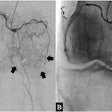The black color of the Onyx embolic is helpful in identifying masses, according to the research team. Onyx also reduced the adverse effects of performing surgery and improved outcomes in patients with juvenile angiofibroma (JNA) and other highly vascularized tumors, they said.
Juergen Lutz, MD, from Ludwig-Maximilians University in Munich (Grosshadern campus) treated 11 patients (mean age, 13 years; range, 11-16) with a diagnosis of JNA who were referred for preoperative embolization over a four-year period. The team evaluated information on tumor type, location, extent of tumor devascularization, endovascular and surgical complications, intraoperative blood loss, and rate of recurrence
Preoperative angiography with transarterial embolization using PVA microparticles was performed on seven patients, and intratumoral Onyx injections were performed in four cases via direct tumor puncture. Punctures were performed under road map fluoroscopic guidance.
Comparing angiography before and after the procedures, the team evaluated patients who underwent the two types of embolization. The Onyx embolizations were shorter in duration and provided more accurate mass identification due to the black color and the radiopacity of the Onyx embolic, Lutz said.
Perhaps more important, patients embolized with Onyx needed no further postoperative intervention, while those treated with PVA microparticles did. But one adverse event in the Onyx embolization group did lead to temporary anticoagulation therapy.



















